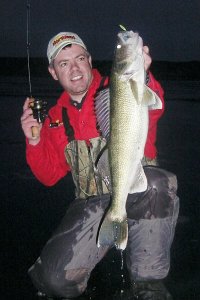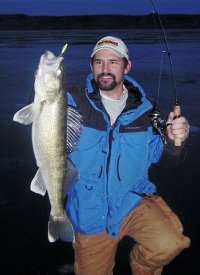
Rattling lures will get the attention of walleyes and attract them to the area. The author caught this trophy walleye was just after dusk on a Buck-Shot® Rattle Spoon jigged aggressively.
Across much of the Midwest and Canada where lakes are clear, nighttime is the right time for winter walleyes. Anglers know that their time is best spent on hard water during low light conditions, particularly the hours that surround dawn and dusk. It’s during these narrow windows that walleyes feed aggressively. Their eyes are built for low-light foraging. Ice fishing fanatics have also discovered tricks that enhance their chances of success during “prime-time”.
Stalk with Stealth
Successful winter walleye anglers employ a couple of strategies that they also likely use when in pursuit of other wild game.
One approach is to mobilize, a concept that has been promoted in most ice articles in recent years. Like a stalking hunter, a solo angler might auger a dozen holes scattered across and/or adjacent to structure such as a point or sunken island and move about, spending a few minutes at each hole before moving on. Parties of 4-6 anglers might punch 50-60 holes before wetting a line. Then, they’ll put the augers away, keeping noise to a minimum until pulling up stakes and moving to a new piece of structure. Cutting additional holes as darkness nears may spook nearby fish. Likewise, noise from ATVs and anglers walking around can make fish wary, especially in shallow water and on thin ice.
The other approach is to play the waiting game. Like a treestand hunter waiting to ambush a deer, an ice angler can experience success by sitting tight, provided he sets up on the right spot. Prime locations often get “claimed” by anglers with permanent shanties. My Otter Sled gets plenty of action as does my permanent icehouse. Set up on a hot spot, my permanent shack produces as many fish each winter as the portable. Permanent shelters are especially convenient during the week for the working man who has to hustle out of the office in time for the evening bite.
Electron-Tricks
The implementation of electronics by ice anglers has dramatically increased their efficiency. The flasher is the most popular variety and allows an angler to detect his lure as well as fish that have moved into the area. When employing the “search and destroy” approach, a few minutes of jigging in a particular hole without detecting life below means it’s time to move on to the next hole. If fish are detected but won’t bite, it’s time to experiment with one’s presentation. Figuring out how to make them bite is part of the fun. It might mean presenting the lure of choice in a different manner, changing the color or size of the lure, or switching to a different type of lure. Without electronics, it’s difficult to know when to move and when to alter the presentation.
Go with Glow
Low light conditions call for glow lures. Today, glow-in-the-dark lures are available in many colors, not just the standard luminescent. UV lure lights like Northland Tackle’s Glo-Buster Lure Light can be used to quickly “recharge” a lure. Jigging spoons, with more surface area than jigs, maximize the alluring qualities of glow paint and increase the strike zone.
Rattle ‘em Up
Rattling lures like the Buck-Shot® Rattle Spoon also increase the strike zone. Walleyes detect vibration and move in to investigate. My favorite winter walleye lure, a 1/4 ounce Buck-Shot® Rattle Spoon in Super-Glo Perch provides noise and glow finish in a single package. Seldom does a walleye appear on the flasher without falling for this offering tipped with a minnow head.
Get Aggressive
Rapid jigging gets the attention of walleye more so than a passive presentation. That’s not to say that aggressive action produces more bites than a finesse approach. But . . . I’m convinced that an aggressive presentation will attract walleyes to the vicinity of my spoon. Most days, a high percentage of those fish that approach close enough to be detected on my flasher, can be coaxed into biting.
Be Prepared
Night fishing requires some forethought and additional gear. It’s very important for ice anglers to know their location after dark. Accidents happen when traveling at night as dangers such as thin ice and even nuisances like slush are less obvious. When fishing the evening bite, taking the same route on and off the ice is the best practice.
 Lights and lots of them are the key to comfortable fishing after dark. Regardless of preference for gas lanterns or battery-operated lights, extras offer insurance. Extra fuel and batteries should be included on the checklist too.
Lights and lots of them are the key to comfortable fishing after dark. Regardless of preference for gas lanterns or battery-operated lights, extras offer insurance. Extra fuel and batteries should be included on the checklist too.
Low light periods are typically the most productive for winter walleyes, particularly in clear water. A stealthy approach near-classic walleye structure with lures that get their attention will put walleyes in the bucket. Don’t forget the camera either as nighttime is the “prime-time” for trophy winter walleyes as well.
The hours which surround dawn and dusk are generally most productive for winter walleyes. Terry Fish of Billings, MT sets up well before the bite begins and allows the area to settle down before “prime-time”.

